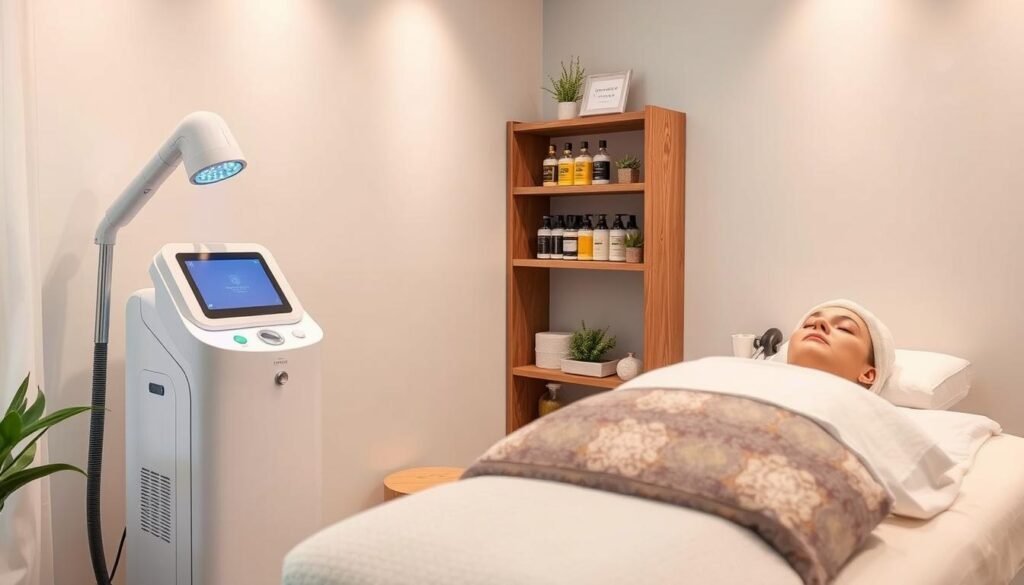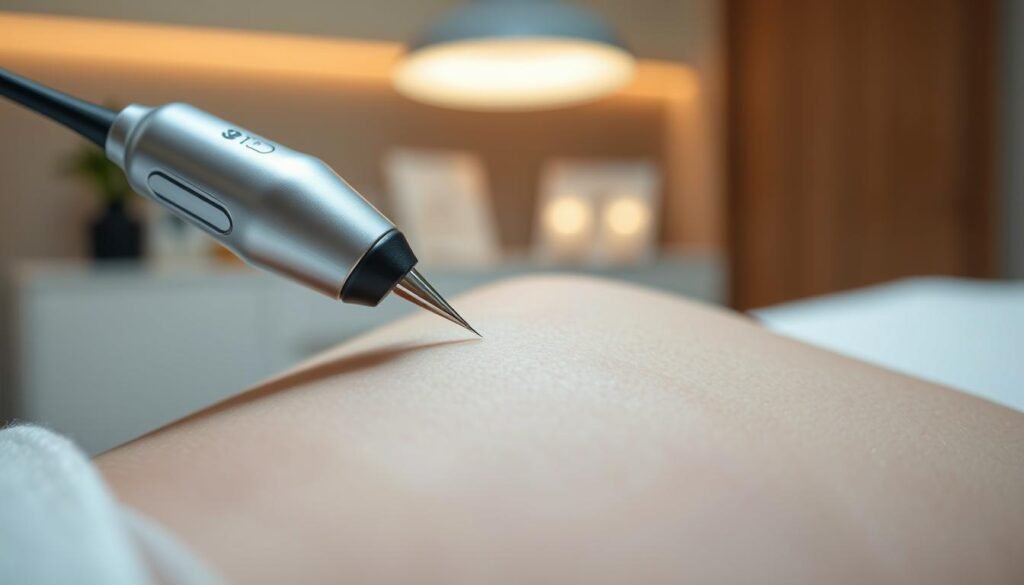Did you know about 70% of women with polycystic ovary syndrome (PCOS) have hirsutism? This condition means they grow too much hair in spots usually seen in men. It’s a big issue affecting many as they handle their health and self-esteem. Learning about hirsutism is key to managing it well. This is because it’s often tied to the hormone issues PCOS causes.
Hirsutism can deeply affect a woman’s life. It changes how she looks and feels about herself. Looking into different ways to manage it is helpful. This includes changing what you eat to balance hormones and cope with insulin problems better. Adding healthy, whole foods to your meals can be a big help. It can ease symptoms and help manage weight, which is crucial for overcoming PCOS. Through smart choices and the right treatments, women can regain control over their health and confidence.
Key Takeaways
- Hirsutism affects around 70% of women with PCOS, making it a prevalent concern.
- Understanding the hormonal imbalances that cause excess hair growth is crucial.
- Dietary changes play a significant role in managing hirsutism and improving overall health.
- Effective treatments range from topical solutions to hormonal therapies.
- Emotional and psychological support is essential for those dealing with hirsutism.
- Incorporating nutrient-dense foods can enhance overall well-being and symptom management.
Understanding Hirsutism and Its Causes
Hirsutism is a major worry for many women. It shows as too much hair growth in a male pattern. This often comes from a hormonal imbalance, leading to high androgens, or male hormones. Knowing why it happens helps us find good ways to manage it.
What is Hirsutism?
Hirsutism means having dark, thick hair where men usually have hair, like the face, back, and belly. This unwanted hair can make women feel bad about how they look. It’s crucial to figure out why it happens to treat it right.
Hormonal Imbalance and Androgens
High androgens, like testosterone, are a big reason for hirsutism. They mess up how hair normally grows, causing too much hair. Checking for a hormonal imbalance helps find the best way to deal with it.
PCOS and Its Link to Hirsutism
Polycystic ovary syndrome (PCOS) is a common cause of hirsutism. Women with PCOS often resist insulin and make more androgens. This makes hair grow more. It’s important to understand PCOS to get the right treatment.
For more on causes of hirsutism and how to handle it, check out resources like the Mayo Clinic.
Symptoms of Hirsutism in Women
Knowing the symptoms of hirsutism is key to understanding how it affects women’s health. It can cause excessive hair growth in different areas, leading to physical and emotional issues.
Physical Signs of Excessive Hair Growth
Women with hirsutism may find hair growing in places usually seen in men, like the chin, upper lip, chest, abdomen, inner thighs, and back. They might also have irregular periods, acne, and thinning hair on their head. These symptoms can change how they look and feel.
Emotional Impact of Unwanted Hair
Having too much hair can make women feel embarrassed, reduce their confidence, and cause anxiety. They often try hard to hide this hair, which can affect their social life and mental health. This emotional toll goes beyond just looks, impacting their everyday life and relationships.
Diagnosis of Hirsutism in Women
Understanding how to diagnose hirsutism is key to managing it well. Doctors use medical evaluations to find what causes excessive hair growth. At the start, they do a full check-up and ask about your medical history. This helps collect important info about your symptoms and factors.
Medical Evaluations and Tests
Different medical tests are crucial for a right hirsutism diagnosis. The tests include:
- Physical Examination: Checking the areas with too much hair and other symptoms.
- Blood Tests: Looking at hormone levels for any unusual findings.
- Imaging Studies: Using ultrasounds to look for things like ovarian cysts.
Assessing Hormonal Levels
Checking hormone levels is vital for diagnosing hirsutism. The main hormone tests include:
| Hormone | Normal Range | Significance |
|---|---|---|
| Testosterone | 15-70 ng/dL | High levels might mean too much androgen. |
| DHEAS | 35-430 mcg/dL | Elevated levels can point to problems with the adrenal gland. |
| Luteinizing Hormone (LH) | 5-20 mIU/mL | Unbalanced levels can mess with ovulation and menstrual cycles. |
The results of these tests show if hirsutism ties back to hormone levels. This is key for choosing the right treatment.
Treatment Options for Hirsutism
Dealing with hirsutism means choosing from various treatments that meet your specific needs. There are topical solutions and oral medications to help. Each one aims at controlling hormone levels to manage excess hair growth.
Topical Treatments and Creams
Eflornithine hydrochloride cream is a go-to topical treatment for hirsutism. Approved by the FDA, it helps slow hair growth where applied. It’s often used with other treatments to enhance outcomes.
Oral Medications for Hormonal Regulation
Oral contraceptives are a key option for hormonal regulation. These pills combine estrogen and progestin, cutting down androgen levels and aiding cycle control. This is helpful for those with hirsutism. Spironolactone, another choice, blocks testosterone’s effects, reducing hair growth.
For more info on hirsutism and treatment choices, check out this page.

Laser Hair Removal: A Popular Solution
Laser hair removal is a favorite choice for people wanting lasting results. It uses cutting-edge technology to precisely target hair follicles. Knowing how it works helps explain why it’s so popular.
How Laser Hair Removal Works
The method uses intense light beams that go through the skin to the hair’s melanin. This damages the follicles, preventing future growth. Many people need several sessions for the best hair reduction.
Benefits and Limitations of the Treatment
Laser hair removal has many pros:
- Long-term cost-effectiveness: In the long run, it can be cheaper than regular salon visits.
- Precision: It specifically targets dark, coarse hairs without harming nearby skin.
- Minimal discomfort: It’s often compared to the snap of a rubber band on the skin.
But it has some drawbacks:
- Less effective on light-colored hair: It might not work well for those with light hair.
- Possible side effects: There can be skin irritation or changes in color, especially for darker skin.
Studies show laser treatment effectively manages unwanted hair, especially in cases like polycystic ovary syndrome. For more details, check out these research findings.
Electrolysis: A Long-Term Hair Removal Method
Electrolysis is a top choice for those who want to get rid of hair for a long time. It works by using a thin needle. This needle sends electricity right into the hair root. Because of this, hair growth stops for good, perfect for any hair or skin type.
Understanding the Electrolysis Process
The steps of electrolysis are as follows:
- Preparation of the treatment area to ensure cleanliness.
- Insertion of a fine needle into the hair follicle.
- Application of an electric current to destroy the follicle.
- Removal of the hair using specialized tools.
This careful method means every single hair can be dealt with on its own. It leads to great results that last a long time.
Comparing Electrolysis and Laser Treatments
Electrolysis and laser hair removal are both ways to reduce hair permanently, but they are different. One works hair by hair and the other targets many hairs at once. Also, electrolysis works for every hair and skin type. Laser is best for light skin with dark hair.
| Feature | Electrolysis | Laser Hair Removal |
|---|---|---|
| Method | Individual follicle treatment | Multiple follicles at once |
| Suitable for | All hair colors and skin types | Light skin with dark hair |
| Treatment duration | Longer sessions | Quicker results |
| Number of sessions | More sessions needed | Fewer sessions typically required |
Choosing between electrolysis and laser comes down to what you prefer, your hair color, and skin type. Thinking about these things will help you pick the best hair removal option.

Hormonal Therapy for Treating Hirsutism
Hormonal therapy is a top choice for those battling hirsutism. It fights the root cause: hormonal imbalances that lead to unwanted hair. It’s vital to know the different hormonal therapies out there. This knowledge can help people choose the best treatment for them.
Types of Hormonal Therapies Available
Hormonal therapies usually consist of:
- Birth control pills: They regulate menstrual cycles and lower androgen levels.
- Anti-androgens: Drugs like spironolactone prevent androgens from affecting hair follicles.
- Finasteride: This drug stops the enzyme that changes testosterone, which helps with hair growth.
How Hormonal Therapy Addresses Excess Hair Growth
Hormonal therapy is key in treating too much hair growth. It reduces androgens, leading to less hair on the face and body. People often see better results when they mix hormonal therapies with changes in lifestyle and other care methods.
Home Remedies to Manage Unwanted Hair
Managing hirsutism often includes various strategies, including effective home remedies. These may help ease symptoms. Many women look into natural remedies and lifestyle adjustments. They aim to reduce excessive hair growth and boost health. Through certain practices, one can help maintain hormonal balance.
Natural Remedies for Mild Cases
For those seeking solutions, specific natural remedies can be helpful. Spearmint tea is known for its ability to decrease androgen levels. This change may reduce symptoms of hirsutism. Other natural approaches include:
- Using turmeric for its anti-inflammatory and anti-androgenic effects
- Applying aloe vera gel for skin soothing
- Using peppermint oil for its potential hormonal benefits
These remedies are easy to find and may offer relief from unwanted hair.
Lifestyle Changes to Support Hormonal Balance
Adopting certain lifestyle changes is key in managing hirsutism. Eating a diet full of whole foods can help regulate hormones. Recommendations are:
- Exercise regularly to keep a healthy weight
- Use stress management techniques like yoga or meditation
- Get enough sleep for hormonal well-being
When combined with home remedies for hirsutism, these changes can lead to better hormonal balance. They can improve well-being gradually. For more on hirsutism and managing it, check this resource.

| Natural Remedy | Benefits |
|---|---|
| Spearmint Tea | May lower androgen levels |
| Turmeric | Anti-inflammatory, might cut down hair growth |
| Aloe Vera | Eases skin irritation |
| Peppermint Oil | Could help balance hormones |
Emotional and Psychological Support
Dealing with hirsutism can be tough, often hurting a woman’s mental well-being. The hidden battles can increase anxiety and depression. It’s crucial to look at the emotional side for complete care.
The Importance of Mental Well-being
Hirsutism affects both the body and mind. It makes many women feel self-conscious. This can cause them to avoid social events. Support from loved ones helps fight these feelings and brings hope.
Seeking Support from Health Professionals
Talking to health experts is key for dealing with hirsutism’s challenges. They suggest therapies like counseling and support groups for emotional support. These professionals also help create a full treatment plan, focusing on both mind and body.
Conclusion
Managing hirsutism starts with knowing its causes and symptoms. For those with PCOS, getting a full diagnosis is vital. They must look into different treatment avenues. With the right advice, dealing with this issue becomes easier.
Medicine and lifestyle changes are key to balancing hormones and boosting well-being. Healthy habits can improve life and reduce hair growth. Getting emotional support helps women feel sure and in charge.
To handle hirsutism better, women should learn about it and seek help. This way, they can be active in their care for a brighter outlook. For more on PCOS, read this detailed guide on recognizing the symptoms of PCOS.